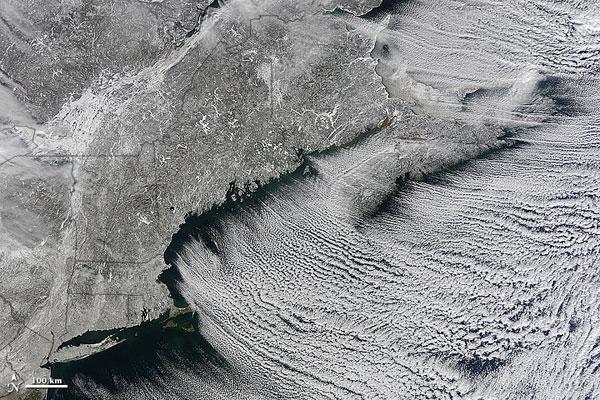
'Cloud Streets' Form Over Atlantic

What do you get when you mix below-freezing air temperatures, frigid northwest winds from Canada, and ocean temperatures hovering around 39 to 40 degrees Fahrenheit (4 to 5 degrees Celsius)? Paved highways of clouds across the skies of the North Atlantic.
NASA's Terra satellite snapped this view of New England, the Canadian Maritimes, and coastal waters at 10:25 a.m. EST on Jan. 24. Lines of clouds stretch from northwest to southeast over the North Atlantic, while the relatively cloudless skies over land afford a peek at the snow that blanketed the Northeast just a few days earlier.
Cloud streets form when cold air blows over warmer waters, while a warmer air layer or temperature inversion rests over top of both. The comparatively warm water of the ocean gives up heat and moisture to the cold air mass above, and columns of heated air thermals naturally rise through the atmosphere. As they hit the temperature inversion like a lid, the air rolls over like the circulation in a pot of boiling water. The water in the warm air cools and condenses into flat-bottomed, fluffy-topped cumulus clouds that line up parallel to the wind.
Some of the finer points of how cloud streets form remain a mystery, according to a NASA statement.
A NASA-funded researcher from the University of Wisconsin recently observed an unusual pattern in cloud streets over the Great Lakes. Cloud droplets that should have picked up moisture from the atmosphere and grown in size were instead shrinking as they moved over Lake Superior.
- Image Gallery: Reading the Clouds
- Infographic: Earth's Atmosphere Top to Bottom
- The World's Weirdest Weather
Get the world’s most fascinating discoveries delivered straight to your inbox.



